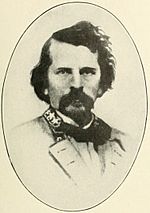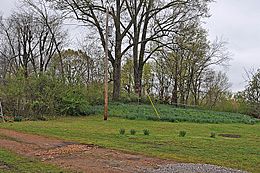Holly Springs Raid facts for kids
Quick facts for kids Holly Springs Raid |
|||||||
|---|---|---|---|---|---|---|---|
| Part of the Western Theater of the American Civil War | |||||||
 Earl Van Dorn |
|||||||
|
|||||||
| Belligerents | |||||||
| Commanders and leaders | |||||||
| Strength | |||||||
| 3,500 | 1,630 | ||||||
| Casualties and losses | |||||||
| negligible | 1,500 captured | ||||||
The Holly Springs Raid happened on December 20, 1862, during the American Civil War. Confederate cavalry, led by Earl Van Dorn, attacked a major Union supply base in Holly Springs, Mississippi. The attack was a complete surprise. The Confederates captured the Union soldiers there and destroyed supplies worth about $1.5 million. These supplies were meant for Ulysses S. Grant's Union army.
After the raid, Van Dorn's soldiers moved north. They followed the Mississippi Central Railroad and destroyed tracks and bridges. They went almost as far as Bolivar, Tennessee, before returning to northern Mississippi. The damage from this raid, along with another raid by Nathan Bedford Forrest, forced Grant's army to go back to Memphis. These raids also delayed a controversial order from General Grant for several weeks. This order, called General Order No. 11, would have forced many Jewish people to leave the military district.
Contents
Why Did the Raid Happen?
After a Confederate loss at the Second Battle of Corinth in October 1862, John C. Pemberton became a Lieutenant general and took charge of the Confederate forces in Mississippi and East Louisiana. This made him Van Dorn's boss.
Meanwhile, Union General Ulysses S. Grant took command of the Department of Tennessee. He began his Vicksburg campaign to capture Vicksburg. Grant gathered nearly 50,000 Union troops near Memphis and Corinth, Mississippi. His plan was to move south along the Mississippi Central Railroad with 40,000 soldiers.
Even though Van Dorn had 24,000 troops, many were sick. As winter approached, more soldiers became ill. On November 9, Van Dorn moved his troops from Holly Springs to a new defense line. Grant kept pushing forward. A Confederate officer, Lieutenant Colonel John S. Griffiths, suggested raiding Grant's supply base at Holly Springs. Pemberton liked the idea. He gave Van Dorn three cavalry brigades to carry out the raid.
Planning the Attack
Van Dorn left Grenada on December 16 with 3,500 cavalry soldiers. He had three groups of horsemen. Colonel John Wilkins Whitfield led the Texas brigade, which had about 1,500 men. William Hicks Jackson led 1,200 Tennessee cavalry. Robert McCulloch led 800 horsemen from Arkansas, Mississippi, and Missouri.
The raiders first marched east to get around the Union army's side. They reached Houston, Mississippi on December 17. Then they turned north to Pontotoc on December 18. After passing New Albany, they turned west. They rested about 12 to 15 miles from Holly Springs that evening.
The Union commander at Holly Springs, Colonel Robert C. Murphy, knew that Confederate forces were in the area. However, he did not warn his soldiers. This was not his first mistake. Before the Battle of Iuka in September 1862, Murphy had left many supplies behind. Grant had forgiven him then, saying he was new to command.
In Holly Springs, the Union troops were spread out. They were in three different places and could not easily help each other. Some cavalry soldiers were camped at the edge of town. The infantry soldiers were camped near the courthouse and at the train station.
The Raid Begins
Van Dorn split his horsemen into three groups. The first group was ordered to attack the first infantry camp right away. The second group would go around the infantry camp and charge into town. They would then attack the cavalry camp. The third group would ride through town and attack the infantry at the public square.
At dawn on December 20, the first and third groups quickly took over the infantry camps. The second group surprised the Union cavalry during an inspection. The Union horsemen fought briefly but were quickly defeated. By 8:00 AM, the fighting was over.
The Confederate raiders then took food and new weapons. They found three full freight trains waiting to be unloaded. The Confederates captured 1,500 Union soldiers. They quickly released them, making them promise not to fight again. About $1,500,000 worth of supplies were burned. Only 130 Union soldiers managed to escape capture.
When Grant heard about the raid, he ordered his troops to chase the Confederates. Van Dorn continued north along the railroad. He captured more Union soldiers and destroyed tracks and bridges. The only place he was stopped was at Davis' Mills. There, Colonel W. H. Morgan and 300 Union soldiers guarded a bridge. Morgan's men defended a blockhouse and an old Indian mound. They caused losses for the raiders, while only three of their own men were hurt. Van Dorn went around Davis' Mills. He continued almost to Bolivar before turning back. The raiders avoided a Union pursuit and returned safely to Grenada on December 28.
What Happened Next?
The historian Shelby Foote said that Van Dorn destroyed Grant's supplies, and Forrest made it impossible to bring more. Because of this, Grant had to retreat. Grant said that his soldiers could not starve when there was plenty of food around. To feed his army, Grant sent wagons to take food from farms and towns within 15 miles of the railroad. Grant was surprised by how much food they found. He realized his soldiers could have lived for two months on what they took. He wrote, "This taught me a lesson."
With Grant's advance stopped, Pemberton could send troops to block William Tecumseh Sherman's river expedition. Sherman's troops landed on December 26. In the Battle of Chickasaw Bayou on December 29, Pemberton easily defeated Sherman's soldiers. The Confederates caused 1,700 Union casualties.
After the disaster at Holly Springs, Colonel Murphy complained that his forces were too small. Grant removed Murphy from the army for his poor leadership.
General Order No. 11
Van Dorn's raid happened around the same time as General Order No. 11. Grant issued this order on December 17, 1862. It said that all Jewish people had to leave Grant's military district within 24 hours. Grant believed that Jewish traders were breaking rules about cotton trade.
Van Dorn's raid broke Union communication lines for weeks. Also, Confederate General Nathan Bedford Forrest's raids, which started on December 10, destroyed communications along 50 miles of railroad. These raids delayed the order from being fully carried out. This saved many Jewish people from being forced to leave. It took 11 days for the order to reach Paducah, Kentucky. Local Jewish leaders there asked President Abraham Lincoln for help. Lincoln told General-in-Chief Henry Halleck to order Grant to cancel General Order No. 11. When Grant ran for president in 1868, this order was very embarrassing for him, and he said he regretted it.
Images for kids



